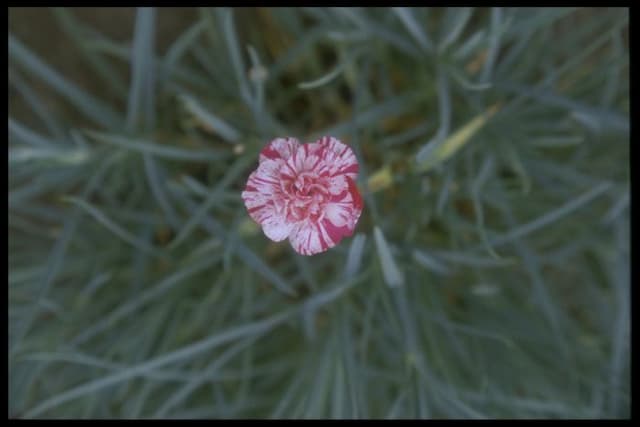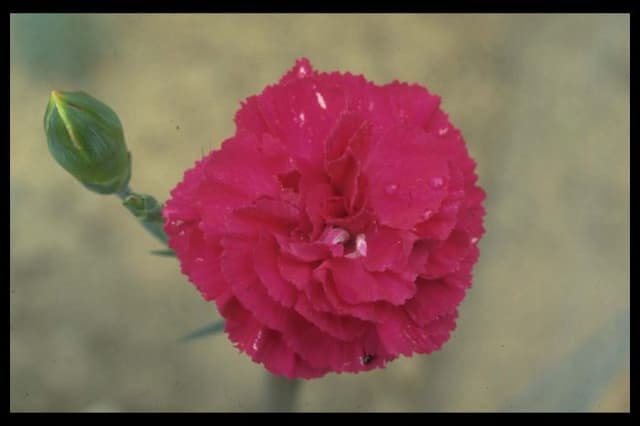Carnation Dianthus 'Cheerio' (pf)

ABOUT
Dianthus 'Cheerio' is an ornamental plant that is characterized by its vibrant and colorful flowers. The blooms are typically a cheerful pink color with fringed petals that create a textured and playful appearance. The edges of the petals might be slightly lighter or darker, giving the flowers a two-tone effect that adds to their overall charm. These flowers often have a strong, pleasant fragrance that can add to the sensory enjoyment of the garden. The foliage of Dianthus 'Cheerio' is also notable, with slender, lance-shaped leaves that provide a lovely contrast to the rounded form of the flowers. The leaves are typically a bluish-green or grey-green hue, which complements the pinks of the blossoms. The plant has a compact, mounding habit, which allows the foliage to form a dense and neat cushion beneath the flowers. One of the distinctive features of this plant is the formation of the flowers at the end of upright stems that emerge from the foliage, giving them a prominent and showy display. The plant tends to produce a profusion of flowers, which can create a stunning visual impact in garden beds, borders, or containers. Overall, Dianthus 'Cheerio' presents an eye-catching combination of bright flowers and attractive foliage that contribute to its popularity for gardeners seeking to add a splash of color and elegance to their outdoor spaces.
About this plant
 Names
NamesFamily
Caryophyllaceae.
Synonyms
Pinks, Sweet William.
Common names
Dianthus 'Cheerio'
 Toxicity
ToxicityTo humans
The plant commonly known as Carnation, specifically the Dianthus 'Cheerio', is generally considered non-toxic to humans. There are no well-documented cases of poisoning from ingesting parts of this plant. However, as with any plant material, individual allergies or sensitivities could potentially cause mild irritation or discomfort if ingested or handled.
To pets
The common Carnation, including the variety Dianthus 'Cheerio', is not typically toxic to pets. It is widely regarded as safe for cats, dogs, and other household pets. While ingestion of this plant is unlikely to cause poisoning, ingestion of any plant material by pets can sometimes lead to gastrointestinal upset, such as vomiting or diarrhea, especially if ingested in large quantities or if the pet is not used to eating plant material.
 Characteristics
CharacteristicsLife cycle
Perennials
Foliage type
Evergreen
Color of leaves
Blue-green
Flower color
Pink
Height
1 foot [30 cm]
Spread
1 foot [30 cm]
Plant type
Herb
Hardiness zones
7
Native area
Europe
Benefits
 General Benefits
General Benefits- Ornamental beauty: Adds vibrant color and visual interest to gardens and landscapes with its showy red or pink flowers.
- Aromatic fragrance: Emits a pleasant spicy or clove-like scent that can enhance the sensory experience of a garden.
- Attracts pollinators: Draws in bees, butterflies, and other pollinating insects, supporting biodiversity and healthy ecosystems.
- Low maintenance: Requires minimal care once established, making it a good choice for gardeners of all skill levels.
- Drought tolerance: Can survive with limited water, making it suitable for xeriscaped gardens and regions with water restrictions.
- Long blooming period: Offers a long season of blooms from late spring to early fall, providing lasting color in the garden.
- Border and edging plant: Its compact growth habit makes it ideal for borders, edging, and small spaces in the garden.
- Container gardening: Well-suited for pots and containers, allowing those with limited space to enjoy its beauty.
- Cut flowers: The blooms can be cut and used in floral arrangements, adding a fresh look and fragrance indoors.
- Variety of uses: Versatile in landscape design, suitable for rock gardens, ground cover, and as an accent plant.
- Deer resistance: Less likely to be eaten by deer, reducing the risk of damage to the plant in areas where deer are prevalent.
 Medical Properties
Medical PropertiesThis plant is not used for medical purposes.
 Air-purifying Qualities
Air-purifying QualitiesThis plant is not specifically known for air purifying qualities.
 Other Uses
Other Uses- Pressed Flower Art: Dianthus petals can be pressed and used in crafting unique and delicate art pieces, such as bookmarks or greeting cards.
- Edible Decorations: The non-toxic petals of Dianthus can be used as edible garnishes on cakes, desserts, and salads for an added elegant touch.
- Fabric Dye: Dianthus flowers have historically been used to produce a light red or pink dye for coloring fabrics and textiles.
- Plant Dye for Soaps: Beyond fabrics, the natural pigments in Dianthus petals can be used to dye homemade soaps for artisanal crafting.
- Sentimental Jewelry: Dried petals from the Dianthus can be embedded in clear resin to create pendants or charms for keepsake jewelry.
- Scented Sachets: Dried Dianthus flowers can be placed in small sachets to subtly scent drawers and closets.
- Potpourri Ingredient: The brightly colored and pleasantly fragranced petals can be added to potpourri mixes for natural home scenting.
- Plantable Confetti: Small pieces of Dianthus petals can be used as a biodegradable alternative to paper confetti at celebrations and weddings.
- Candle Embeds: Drying the petals and embedding them into the wax of homemade candles can add a decorative and fragrant element.
- Fragrance for Bath Salts: Dianthus petals can be mixed with bath salts to infuse them with a delicate scent for a luxurious bathing experience.
Interesting Facts
 Feng Shui
Feng ShuiThe Dianthus or "pinks" can be used in Feng Shui to introduce vibrant energy into your home or garden. Their bright flowers are believed to bring about joyful vibrations, good luck, and positive qi. To harness these effects, plant Dianthus in areas that you want to energize or in the South sector of a garden or room to enhance fame and recognition.
 Zodiac Sign Compitability
Zodiac Sign CompitabilityThe Dianthus is not used in astrology practice.
 Plant Symbolism
Plant Symbolism- Love: Dianthus 'Cheerio', commonly known as Pinks, often symbolizes love and affection due to their long association with the Greek god Zeus (Dios) and the flower's common name deriving from the word 'pinks' which sounds similar to 'pinctures,' hinting to the idea of a love so profound it pinches the heart.
- Boldness: With their bright and vivid coloration, Pinks can represent boldness and daring, encouraging an attitude of fearlessness and a willingness to take risks.
- Admiration: The floral language often uses Dianthus flowers to convey admiration, with their intricate patterns and spicy fragrance illustrating the complexity and depth of one's fondness for another.
- Pure Affection: Unlike the intense passion red roses might symbolize, Pinks are often associated with a more subtle, platonic, or innocent kind of affection, often shared among friends.
- Longevity: As Dianthus species are known for their longevity and hardiness, they can symbolize the wish for a long life or the endurance of an individual or relationship.
 Water
WaterFor the Carnation, commonly known as Dianthus 'Cheerio', watering should be done carefully to maintain moist soil without causing waterlogging. It is advisable to water these plants once or twice a week, depending on weather conditions, with approximately one to two gallons of water each time. During the growing season, ensure a consistent watering schedule, and reduce frequency in winter. Water at the base of the plant to avoid wetting the foliage, which can lead to fungal diseases.
 Light
LightCarnations, or Dianthus 'Cheerio', thrive best in full sun conditions. They prefer a location where they can receive at least six hours of direct sunlight daily. An east or south-facing spot is ideal, ensuring the plant gets the morning sun, which is less harsh than the afternoon sun.
 Temperature
TemperatureCarnations, known as Dianthus 'Cheerio', perform well in a range of temperature conditions. They can survive temperatures as low as 40 degrees Fahrenheit and can handle heat up to about 85 degrees Fahrenheit. The ideal temperature range for these plants is between 60 and 70 degrees Fahrenheit.
 Pruning
PruningPruning Carnations, known as Dianthus 'Cheerio', helps to promote bushier growth and prevent leggy stems. Pinch back the tips of the plants in early spring, and after flowering, cut back the stems that have finished blooming to encourage a second flush of flowers. Pruning is typically done annually or after blooming cycles.
 Cleaning
CleaningAs needed
 Soil
SoilThe Pinks (Dianthus 'Cheerio') thrive in a well-draining, loamy or sandy soil with good organic content. The best soil pH for this plant is slightly alkaline, between 6.7 to 7.5. A soil mix of one-third garden soil, one-third sand or perlite, and one-third compost or well-rotted manure is ideal.
 Repotting
RepottingPinks (Dianthus 'Cheerio') typically do not need frequent repotting and can be repotted every 2-3 years. It is best to repot in the spring before new growth begins.
 Humidity & Misting
Humidity & MistingPinks (Dianthus 'Cheerio') prefer moderate humidity but are quite adaptable. The best humidity level for this plant ranges from 40% to 60%, avoiding overly humid conditions to prevent fungal diseases.
 Suitable locations
Suitable locationsIndoor
Place Pinks in a bright spot, water sparingly, and ensure good air circulation.
Outdoor
Plant Pinks in a sunny area with well-draining soil and space for air flow.
Hardiness zone
3-9 USDA
 Life cycle
Life cycleThe life of the Sweet William 'Cheerio' begins with seed germination, where seeds sprout in warm, moist soil conditions, typically in late spring or early summer. Following germination, the seedlings develop into juvenile plants with a basal rosette of leaves, during which time they establish a strong root system and foliage. As they mature, the Sweet William 'Cheerio' enters the vegetative stage, wherein the plant continues to grow foliage and strengthens in preparation for blooming. The flowering stage comes next, usually in the late spring of the following year, when the plant produces clusters of fragrant pink, red, or white flowers that attract pollinators. After pollination, the flowers develop into capsules containing seeds, marking the reproductive stage of the life cycle. Finally, as the seasons change, the plant may either die back, completing its life cycle if it is treated as a biennial, or it may enter a period of dormancy over the winter to begin the cycle again if maintained as a perennial.
 Propogation
PropogationPropogation time
Spring-early summer
The Dianthus 'Cheerio', commonly known as the Carnation 'Cheerio', is often propagated through the method of taking cuttings. This is typically done in late spring to early summer when the plant has vigorous growth. To propagate by cuttings, one selects healthy, non-flowering stems and cuts a 4-6 inch length. The lower leaves are removed, and the cut end is dipped into rooting hormone powder to encourage root development. This cutting is then placed into a pot with a mix of half perlite and half peat moss (or a similar well-draining medium) and kept moist. The pot is placed in a well-lit area but out of direct sunlight until roots have established, usually in a few weeks. After rooting, the new plant can be transplanted into the garden or a more permanent container.





![Pink [Coconut Sundae]](/_next/image?url=https%3A%2F%2Fplants-admin.emdemapps.com%2Fimages%2Fplants%2F%2Fimages%2F604b5d09d4fd1.png&w=640&q=75)



